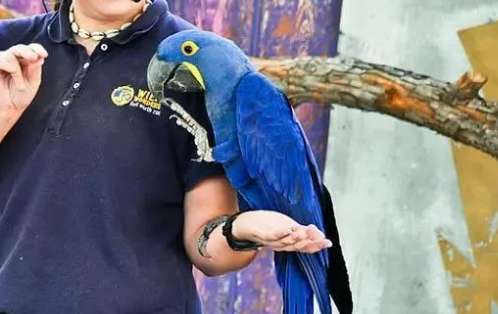Speaking of the most popular bird species, it must be the parrot, colorful The colorful feathers and humorous speaking ability are all parrots. But we may not know that there are actually many varieties of parrots, and not all of them can be raised artificially. What I want to tell you today is whether the purple-blue macaw, the largest member of the Psittacidae family, can be raised?

Purple and Blue Macaw While parrots cannot be kept by individuals, purple-blue macaws are of economic significance to humans, and interest in the birds has sparked a boom in tourism in Brazil. They are also part of the international live bird trade. Capturing and exporting wild birds (although illegal in Brazil) has caused a dramatic decline in the species' numbers. Over-exploitation of agriculture and animal husbandry has seriously destroyed the habitat. Parrot poachers covet their high prices, causing the unfortunate deaths of many purple and blue macaws every year. In 1986, it was estimated that the number of individuals in the wild was 1,500 to 1,000. However, 95% of the main reasons why the number cannot be increased is due to the serious shortage of nests derived from habitat destruction. These various factors make the purple and blue macaw face the crisis of extinction in the wild.
This species has been subject to large-scale illegal trade. At least 10,000 wild birds were captured in the 1980s, 50% of which were shipped to the Brazilian market. During 1983-1984, there were over 2,500 individuals in Bahia Negra, Paraguay, and 600 individuals in the late 1980s. While these numbers have decreased significantly, the illegal trade continues, for example, between August 2004 and July 2005, 10 birds passed through a pet market in Santa Cruz, Bolivia, changing hands for $1,000, and shipped to Peru).
Bolivia in 2012 and Brazil in 2015 had almost no illegal trade. Within its range there is some local food and feather hunting. In the Amazon basin, habitats are being destroyed by cattle ranching and hydroelectric projects in Tocantins and Xinnu. In the Pantanal, only 5% of trees had suitable burrows in 1996. Young trees and food tree species are often exposed to fire. Gilas state is rapidly transforming into mechanized farms, cattle ranches and exotic tree plantingsdistrict. In Paraguay, the species' preferred habitat was deemed seriously threatened in 2013, and in 2014 the Paso Bravo National Park suffered from illegal logging and hunting.

There are many international organizations dedicated to purple-blue macaws. Due to the intervention of wildlife conservation organizations, the estimated total number of macaws rose to about 6,500 in 2003. The purple-blue macaw was listed as an endangered species (IUCN) before 2013, but it was downgraded to vulnerable in 2014. It is hoped that these efforts will allow these beautiful large parrots to soar in their boundless skies forever. Caged purple and blue macaws are sometimes very noisy, and their powerful beaks bite very hard. Sometimes even solid cages will be destroyed by them. They are very destructive. Thick branches must be provided for them to bite. Curious. It has a strong heart and can quickly adapt to the new environment and owner. After adapting to the environment, it becomes very strong and can be kept with other large macaws outside the breeding period.